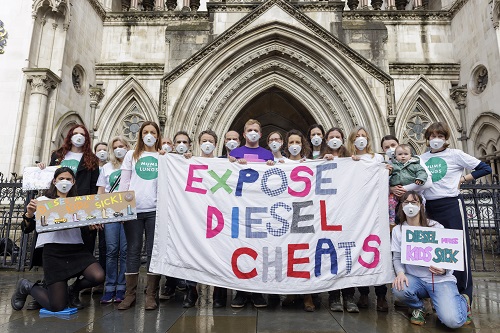Despite decades of effort by many experts and a large body of evidence about the scale of the problem, the topic of indoor air quality (IAQ) in public buildings has attracted little attention beyond readers of professional journals where papers on indoor air pollution and its impacts are published. The Covid-19 pandemic changed this.
Opinion
Clean indoor air in public buildings: can this be achieved?
The call for a paradigm shift to combat indoor respiratory infection and for improving building ventilation systems came from our interdisciplinary group early in the pandemic (Morawska et al. 2021) and we subsequently provided a “blueprint” for a regulatory approach to IAQ (Morawska et al. 2024).
 Photograph: iStock/Kira-Yan
Photograph: iStock/Kira-Yan
The reaction to the first paper was: “Interesting”, but the second paper started a debate. Some said: “Yes indeed”, while others considered that a voluntary market-driven approach would work. Some turned away: “It’s too difficult”, and yet others were surprised: “Is this an issue?”.
Why does indoor air quality matter?
People in developed countries spend over 90 per cent of their time indoors, breathing indoor air 12 times a minute. However, it rarely occurs to people that if the air is polluted it will make them sick, in many different ways.
There is solid scientific evidence demonstrating the impact of air pollution, both indoors and outdoors, on health. This science was the foundation for the latest World Health Organization Air Quality Guidelines (WHO 2021), which recommended lower concentrations than before of particulate matter (PM2.5 and PM10: mass concentration of particles smaller than 2.5 and 10 micrometres, respectively), carbon monoxide (CO), nitrogen dioxide (NO2) and ozone (O3).
Beyond the impact of these pollutants that originate from indoor and outdoor sources, IAQ is also affected by pathogens, viruses and bacteria emitted by occupants, and their presence in indoor air leads to airborne infection transmission.
Needless to say, inhalation of these pollutants has an impact on health. If human health is affected, this also has an impact on productivity, performance, absenteeism and the economy. A report published in Australia in 1998 estimated that the costs of indoor air pollution to the country were $12 billion (Brown 1998), and this assessment did not include the costs of infection transmission. A recent study conducted in China reported that the cost of indoor air pollution (in residential houses) is 3.5 per cent of the GDP of the country. These figures demonstrate why we need clean indoor air.
The fact that we are having this conversation in the 21st century is astonishing. No one contests the need for drinking water standards: we confidently turn the tap on and drink. No one suggests that food quality standards should be voluntary and that we should “smell” the food in the supermarket to decide if it is safe to buy and eat. However, society’s ignorance about IAQ is so deep that we don’t even consider it a problem and most people don’t know that it is not regulated.
In other words, it is not only that we do not “smell” the air upon entering the supermarket, school or office building to check if it is safe, we don’t even realise that the air there can be unsafe.
Why must indoor air quality be mandated?
Firstly, we need to clarify that mandating IAQ is not the same as improving building construction codes. These two types of regulations are often confused. Building construction codes are design standards, which do not require monitoring of the building’s performance in relation to IAQ after the building is commissioned. This is why a separate regulation for IAQ performance standards is necessary, requiring continuous monitoring of IAQ in real time.
 Professor Lidia Morawska is director of the International Laboratory for Air Quality and Health (ILAQH) at Queensland University of Technology (QUT) in Brisbane, Australia
Professor Lidia Morawska is director of the International Laboratory for Air Quality and Health (ILAQH) at Queensland University of Technology (QUT) in Brisbane, Australia
Without monitoring, how would we know that a building (even if it was designed to provide clean indoor air) is performing effectively? Without monitoring, faults in delivering clean air would not be detected, and if the operation of the building changed post-occupancy, the impact on IAQ would not be considered. Setting IAQ performance standards would put indoor air quality on a par with outdoor air quality, which is mandated and monitored for quality by a network of monitoring stations.
It is also important to emphasise that controlling ventilation alone only partially addresses the issue: if outdoor air is polluted, bringing it indoors (to remove pollutants generated inside) resolves one issue but creates another.
The updated UK building regulations (HM Government 2021) have moved towards the path of mandating IAQ, indicating that occupiable rooms in new offices and public buildings should have some means of monitoring IAQ. This recommends CO2 monitors, although some suggested performance standards for other pollutants including CO, ozone and NO2 are also given. However, this only applies to new buildings; the vast majority of our current building stock will remain with us for a substantial number of years to come.
There are suggestions that rather than imposing mandates, IAQ could be improved by a market-driven approach: buildings rated as “clean” and marketed as having excellent indoor air quality will be more sought after.
 Photograph: iStock/Piotrekswat
Photograph: iStock/Piotrekswat
So far there is no evidence that this would result in actual improvement in IAQ in all public buildings. There are strong drivers to lower building construction costs to the bare minimum, and any increase in costs to improve air quality is unlikely to be considered if IAQ is not mandated. There is also the possibility that buildings will be designated as “clean” with little basis if actual monitoring is not required, and the outcomes are not compared with the standard.
How can IAQ be regulated?
It is proposed that concentrations of three pollutants (PM2.5, CO, and CO2) are regulated as well as one parameter (ventilation rate), based on (Morawska et al. 2024) and according to the following brief rationale:
- PM2.5 and CO are of significant health risk, and they are also proxies for other pollutants emitted from the same indoor and/or outdoor sources; exposure response relationships are already available for them, based on which the WHO developed recommendations for their concentrations.
- CO2 is a proxy for infection transmission and for ventilation.
- The three pollutants are easy to monitor and thus can be routinely monitored in real time, based on the existing technologies. CO2 is already monitored in modern buildings (but not for the purpose of controlling IAQ). While some would like many potentially harmful pollutants in the indoor environment to be regulated, realistically, few can be routinely monitored, and a standard cannot be enforced if monitoring is not possible.
- The ventilation rate in mechanically ventilated buildings is a principal control measure for delivering clean air to indoor spaces.
The paper (Morawska et al. 2024) also outlines the key aspects in the development of laws for a ‘healthy’ IAQ, including:
- International scientific standards that define IAQ and identify the means of measuring it.
- Legislation that expressly includes laws for a ‘healthy’ IAQ.
- Whether to include reference to international scientific standards in legislation as a means of measuring IAQ for monitoring and enforcement.
- Whether to include IAQ within the scope of existing legislation or whether to introduce new IAQ-specific legislation.
- Whether legislation is to be at a national or state level and whether co-ordination is required between different levels of government.
- The scope of the laws relating to IAQ. Of particular importance is the issue of which indoor spaces are regulated.
- Requirements for monitoring and enforcement of IAQ.
What timescale should be used for mandating IAQ?
One particular concern when considering IAQ regulations is the timeline for the change, with many fearing that the cost, complexity and scale of this undertaking makes it impossible. The scale is indeed massive: every public building and each space in that building.
But let’s look at it this way. No public building (and for that matter any building) had a plumbing system until the 19th century before publication of the British Sanitary Report (Chadwick 1842) and the government initiative to encourage cities to organise clean water supplies and centralised sewage systems. Now all of them do, and this was less than 200 years ago – a blink of an eye in human history. No building had smoke alarms before 1977 (ISCAIP Collaborators 1999) and now, 50 years later, smoke alarms are mandatory in all spaces of public buildings in most countries.
CO2 sensors are already mandated in Belgium (Lewis 2023). In the UK the need for increasing prominence of health and wellbeing in building regulations and establishing in-use regulations for safe and healthy building performance with effective mechanisms for compliance has been clearly identified by the Royal Academy of Engineering (2022).
We are not suggesting that a change in mandating IAQ can be carried out instantaneously. But as a society we are equipped with functioning regulatory processes capable of designing and implementing the necessary regulatory steps to enforce the following conditions:
- New buildings are designed to meet the standards and are equipped with systems to monitor performance. The timeframe to implement this should be no more than several years and the recent update to the UK building regulations is a welcome step in this direction.
- Planned retrofitting of existing buildings should include steps necessary to meet the standards, with a timeframe of 20 years for all existing buildings to meet the standards.
- In the interim, buildings that do not meet the standards and which cannot be retrofitted on a short timeframe should implement eVentilation means (equivalent ventilation), including air purification and/or air disinfection to ensure good IAQ.
Acknowledgement:
This paper (Morawska et al. 2024) was supported by the “ARC Training Centre for Advanced Building Systems Against Airborne Infection Transmission” (IC220100012).
About the authors
Professor Lidia Morawska is director of the International Laboratory for Air Quality and Health (ILAQH) at Queensland University of Technology (QUT) in Brisbane, Australia, which is a WHO Collaborating Centre for Air Quality and Health. She is a professor in the School of Earth and Atmospheric Sciences, at QUT; and vice chancellor fellow at the Global Centre for Clean Air Research (GCARE), School of Sustainability, of Civil and Environmental Engineering, Faculty of Engineering and Physical Sciences, at University of Surrey. Email: l.morawska@qut.edu.au
Professor Prashant Kumar is founding director of GCARE, co-director of the Institute for Sustainability, University of Surrey, and professor and chair in air quality and health at University of Surrey.
Professor Catherine Noakes is professor of environmental engineering for buildings at the School of Civil Engineering, University of Leeds.
References
Allen, J.G.; Cao, X.; Cadet, L.R.; Chen, Y.; Corsi, R.; Grier, K.; Levinson, M.; Li, Y.; Macomber, J.; Marr, L.; Michaels, D.; Miller, S.; Morawska, L.; Munro, A.; Pollock, N.; Rainbolt, M.; Azimi, P.; Keshavarz, Z.; Jones, E. Proposed Non-infectious Air Delivery Rates (NADR) for Reducing Exposure to Airborne Respiratory Infectious Diseases. The Lancet COVID-19 Commission Task Force on Safe Work, Safe School, and Safe Travel 2022; November 2022
Brown, S.K. Beating the $12 Billion Cost of Polluted Air. Commonwealth Scientific and Industrial Research Organisation; 1998
Chadwick, E. Report on the Sanitary Condition of the Labouring Population of Great Britain. 1842
ISCAIP Collaborators. International smoke detector legislation. Injury Prevention 1999; 5:254-255
Lewis, D. Indoor air is full of flu and COVID viruses. Will countries clean it up? Nature 2023; 615:206-208
Morawska, L.; Allen, J.; Bahnfleth, W.; Bennett, B.; Bluyssen, P.M.; Boerstra, A.; Buonanno, G.; Cao, J.; Dancer, S.J.; Floto, A. Mandating indoor air quality for public buildings. Science 2024; 383:1418-1420
Morawska, L.; Allen, J.; Bahnfleth, W.; Bluyssen, P.M.; Boerstra, A.; Buonanno, G.; Cao, J.; Dancer, S.J.; Floto, A.; Franchimon, F. A paradigm shift to combat indoor respiratory infection. Science 2021; 372:689-691
WHO. Guidelines for Indoor Air Quality, Selected Pollutants World Health Organization. Geneva, Switzerland; 2010
WHO. WHO Global Air Quality Guidelines: particulate matter (PM2.5 and PM10), ozone, nitrogen dioxide, sulfur dioxide and carbon monoxide. World Health Organization. Geneva, Europe; 2021
OPINION

The air we share: why tackling pollution protects us all
By Scott Paul, Mums for Lungs on 04 April 2025
Air pollution is often invisible; its impact is anything but. Whether you’re a parent worried about your child’s lungs, a construction worker breathing exhaust fumes, or a commuter passing through busy streets, polluted air is everyone’s problem.

Why electric cooking is the future we need
By Tushar Nair, Global Cooksafe Coalition on 01 April 2025
The way we cook is more than just a matter of taste and convenience – it’s a critical climate, health, safety, and economic issue. Despite the growing momentum toward building electrification, cooking remains one of the last strongholds of fossil fuel reliance in our homes and commercial kitchens.

Beyond compliance: why noise control must evolve beyond PPE
By Gill Cussons, Noise & Vibration Solutions on 13 March 2025
Engineering solutions for noise control on plant, machinery and tools are often straightforward, low-cost and bring financial savings themselves, so it’s time employers moved away from the default position of purchasing and issuing personal hearing protection to workers.



